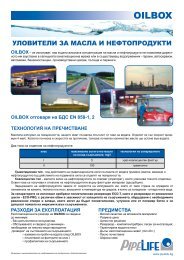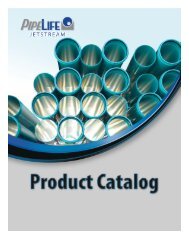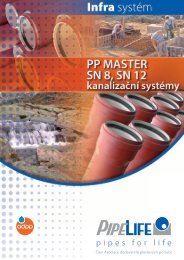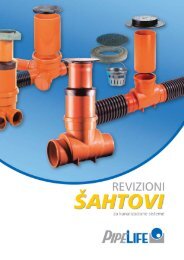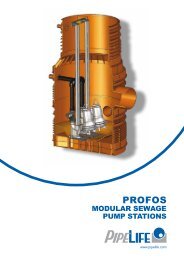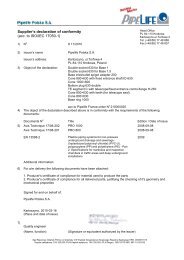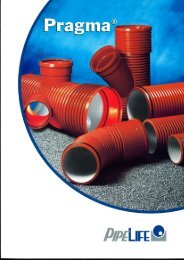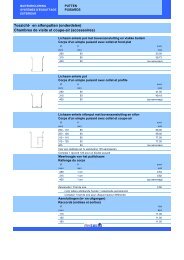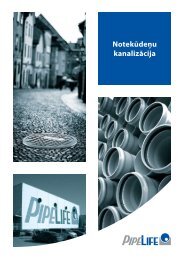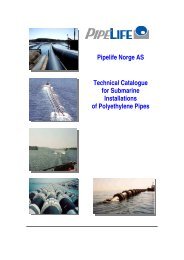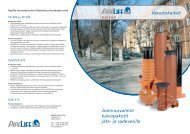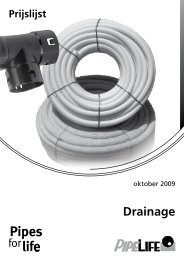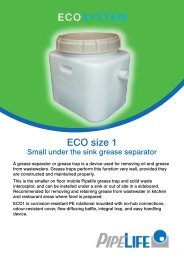Create successful ePaper yourself
Turn your PDF publications into a flip-book with our unique Google optimized e-Paper software.
6.3.2 Degree of compaction<br />
The required degree of fill compaction<br />
depends on loading conditions.<br />
● In paved areas, the minimum soil<br />
compaction in the pipe zone is 90% of<br />
modified Proctor test density.<br />
● Outside of paved areas, the fill<br />
should be compacted to:<br />
6.3.3 Final backfill<br />
The material used for completing the<br />
backfilling can be made with excavated<br />
material if suitable to achieve the required<br />
project compaction and can have<br />
maximum particle size of 300 mm.<br />
- 85% of modified Proctor test density if<br />
the depth of cover is < 4.0 m;<br />
- 90% of modified Proctor test density if<br />
the depth of cover is ≤ 4.0 m.<br />
The fill material should be compacted to<br />
layers of 10 to 30 cm in thickness.<br />
The thickness of the initial backfill over<br />
For pipelines of diameter D < 400 mm<br />
and with an initial backfill thickness of 15<br />
cm, the final backfill material should not<br />
contain particles of size > 60 mm.<br />
In paved areas, the minimum compacthe<br />
crown of the pipe should be:<br />
● minimum 15 cm for a pipe of diameter<br />
D < 400 mm;<br />
● minimum 30 cm for a pipe of diameter<br />
D ≤ 400 mm.<br />
tion of the final backfill should be 90% of<br />
modified Proctor test density.<br />
6.3.4 Tamping of the embedment material<br />
The requirements for the degree of sealing<br />
depend on the general load and must<br />
be defined in the design documentation.<br />
The tamping must be made with different<br />
types of tamping. Depending on the<br />
equipment, the layers’ thickness and<br />
the soil susceptibility, different results of<br />
sealing can be achieved. Table 3.2 gives<br />
data which are related to gravel, sand<br />
clay and alluvium soils.<br />
Equipment<br />
Weight<br />
[kg]<br />
Maximal layer’s<br />
thickness before<br />
compaction [m]<br />
gravel,<br />
sand<br />
COMPACTION METHODS<br />
loam, clay,<br />
silt<br />
Maximal<br />
thickness<br />
of the initial<br />
backfill above<br />
pipe<br />
[m]*<br />
Number of passes to obtain compaction<br />
85%<br />
modified<br />
Proctor test<br />
90%<br />
modified<br />
Proctor test<br />
95%<br />
modified<br />
Proctor test<br />
Close treading - 0.10 - - 1 3 6<br />
Hand tamping min. 15 0.15 0.10 0.30 1 3 6<br />
Vibrating tamper 50-100 0.30 0.20-0.25 0.50 1 3 6<br />
Table 3.2 Compaction methods<br />
Separated<br />
vibrating plates **<br />
Vibrating plate<br />
50-100 0,20 - 0.50 1 4 7<br />
50-100<br />
100-200<br />
400-600<br />
-<br />
-<br />
0.20<br />
* before compacting equipment is used<br />
** to compact the soil on both sides of the pipe<br />
0.50<br />
0.40<br />
0.80<br />
1<br />
1<br />
1<br />
4<br />
4<br />
4<br />
7<br />
7<br />
7<br />
6.3.5 Trench width<br />
The width of the trench should enable the proper placement and compaction of the fill material. The minimum width of the sidefill is<br />
b min =30 cm. Thus, the minimum width of the trench (B) at the top of the pipe is:<br />
B = D + (2 x b min )<br />
If the stiffness of the native undisturbed ground is lower than the stiffness of the designed fill, the trench width (B) should be:<br />
(in general, this condition deals with <strong>pipes</strong> in diameter dn > 250 mm because for <strong>pipes</strong> of smaller diameter the trench width (B) fills<br />
this condition)<br />
B ≥ 4 x d n<br />
Such situations can take place in granular soils of low density (I D < 0.33) or in cohesive soils of plastic limit I L > 0.0.<br />
6.3.6 Filling necessary for achieving the desired angle of laying<br />
Pipelife<br />
www.pipelife.com<br />
D out<br />
DN<br />
[mm]<br />
D out<br />
[mm]<br />
Angle of laying 2α<br />
60° 90° 120° 180°<br />
h 2α [cm]<br />
DN/OD160 160 1 2 4 8<br />
DN/OD200 200 1 3 5 10<br />
DN/OD250 250 2 4 6 12<br />
DN/OD315 315 2 5 8 16<br />
DN/OD400 400 3 6 10 20<br />
DN/ID500 573 4 8 14 29<br />
DN/ID600 688 5 10 17 34<br />
DN/ID800 925,2 6 14 23 46<br />
DN/ID1000 1140,4 8 17 28 57<br />
15



